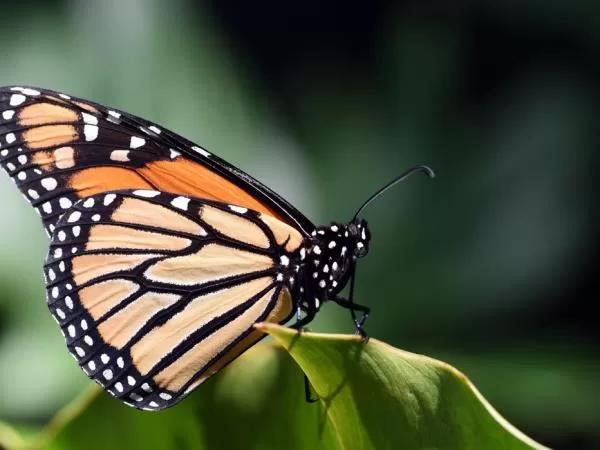
The Extraordinary Migration of Monarch Butterflies
The Great Monarch Migration is one of the most extraordinary phenomena of survival in the animal kingdom. Every year, millions of monarchs embark on an epic journey from Canada and the United States to overwintering sites in Mexico and California. This journey, which can span up to 4,800 kilometers (3,000 miles), makes it one of the longest migrations of any insect. In fact, the monarch’s ability to navigate such vast distances is a testament to its resilience and remarkable instincts.

NPS graphic/ S. Sparhawk
The Route of the Monarch Butterfly Migration
Moreover, what makes this migration even more fascinating is that no single butterfly completes the round trip. The monarchs that travel south in the fall are not the same individuals that return north in the spring. Instead, it takes several generations to complete the full cycle. Thus, the butterflies that leave in the fall will not live to see the return journey. However, their descendants will make the long trek back, guided by instinct and environmental cues.
This migration cycle is a true marvel of nature and has puzzled scientists for years. Despite being raised in different locations, successive generations of monarchs instinctively know the migration route. As a result, their remarkable ability to find their way to the exact same overwintering sites year after year remains a subject of ongoing research.
The route monarchs take for their multi-generation journey. Western monarch populations also make similar, shorter journeys, but populations in the East are the only monarchs in the world known to have an adventure spanning so many generations.

Note monarch caterpillars rely on milkweed for food
from March through August.
From the book Monarchs and Milkweed, courtesy of Anurag Agrawal.
Population Decline. Unfortunately, the monarch population has been in decline for the last 20 years, with historically low numbers occurring in the last five years. There are many reasons for the decline, but the most relevant to Iowa is the loss of caterpillar food (milkweed) in the Midwest because of land converted to agriculture.

Follow the Monarch Butterfly Migration in Real-Time 🦋
Embark on an incredible journey with the Monarch Butterflies as they travel thousands of miles during their annual migration. Using this interactive map, you can track their progress, learn about their challenges, and discover the critical role they play in our ecosystem. Stay updated on their path and join the effort to protect these remarkable creatures.
If you’d like to explore more ways to track or learn about the Monarch Butterfly migration, you can use the following links:



The Challenging Journey and the Importance of Migration
In addition to the biological marvel of the journey, monarchs face significant challenges along the way. During their migration, they rely on environmental cues such as the position of the sun and the Earth’s magnetic field to navigate. Furthermore, these butterflies possess an innate sense of direction that helps them travel long distances with incredible accuracy. Along the way, monarchs stop to rest and feed on nectar, replenishing their energy reserves. Their primary food source is nectar from various wildflowers, which fuels them for the long journey ahead.
However, this migration is far from easy. Along the way, monarchs face numerous challenges, including extreme weather, predators, and the depletion of nectar sources. Despite these obstacles, their survival instincts drive them forward, allowing the species to continue this awe-inspiring journey.
The Great Monarch Migration: A Multi-Generational Journey
Moreover, what makes this migration even more fascinating is that no single butterfly completes the round trip. The monarchs that travel south in the fall are not the same individuals that return north in the spring. Instead, it takes several generations to complete the full cycle. Thus, the butterflies that leave in the fall will not live to see the return journey. However, their descendants will make the long trek back, guided by instinct and environmental cues.
This migration cycle is a true marvel of nature and has puzzled scientists for years. Despite being raised in different locations, successive generations of monarchs instinctively know the migration route. As a result, their remarkable ability to find their way to the exact same overwintering sites year after year remains a subject of ongoing research.

Population Decline and Challenges
Unfortunately, the monarch population has been in decline for the last 20 years, with historically low numbers observed in the past five years. One of the main reasons for this decline is the loss of caterpillar food (milkweed) in the Midwest, due to land conversion for agriculture. As a result, the shortage of suitable habitats is directly impacting the success of this extraordinary migration.
Protecting the Great Monarch Migration: Conservation Efforts
Ultimately, the monarch butterfly’s migration plays a critical role in the survival of the species. However, this incredible phenomenon is threatened by habitat loss, climate change, and human activities. Therefore, protecting the monarchs’ migratory routes and the habitats they rely on is essential for ensuring their continued existence. Conservation efforts are vital to preserve milkweed plants, which serve as both a food source and a breeding ground for monarch caterpillars.


